Recovery takes shape at Air Force’s typhoon-battered base in Guam
Three months after Typhoon Mawar became the strongest storm to hit Guam since 2002, Andersen Air Force Base is getting back on its feet.
All base services, like stores and the daycare, are operational with regular hours, 36th Wing spokesperson 1st Lt. Ariana Wilkinson said Thursday.
Nearly $2M available for military families in Guam after typhoon
Airmen are again allowed to begin new jobs in Guam, following a 60-day order to stop troops from moving to the U.S. territory. Andersen’s displaced population, which totaled around 400 airmen and their dependents as of early June, has shrunk to zero.
And this weekend, staff at the on-base airport will begin checking in passengers for overseas flights from a cluster of portable trailers — their second temporary office space since the storm wrecked Andersen’s passenger terminal.
It’s the first steps of a process that could take one to two years, if not longer, to return the Air Force’s westernmost outpost in the Pacific to its pre-storm state. The service declined to answer how much the effort may cost, citing a complex web of decisions across multiple branches of the military that have installations on Guam.
Restoring the base that bills itself as America’s “forward edge of the Indo-Pacific” is as critical to global security as it is for the well-being of troops living there, military officials argue.
The Pentagon views China as America’s top competitor in military strength, technology development and global influence. Defense leaders are also wary of Beijing’s growing aggression toward Taiwan, the democratically self-governed island that maintains military and trade ties with the United States but is claimed by China.
That makes Andersen, which sits about 1,900 miles from the Chinese mainland and within reach of U.S. allies in the Pacific, a strategic boon in future emergencies.
“Guam is of enormous importance,” Gen. Mike Minihan, the Air Force’s top mobility officer, told Air Force Times during a trip to Andersen in July. “If there were anything from crisis to conflict out here, it’s a place that we would fight from, and it’s a place that we would fight for.”
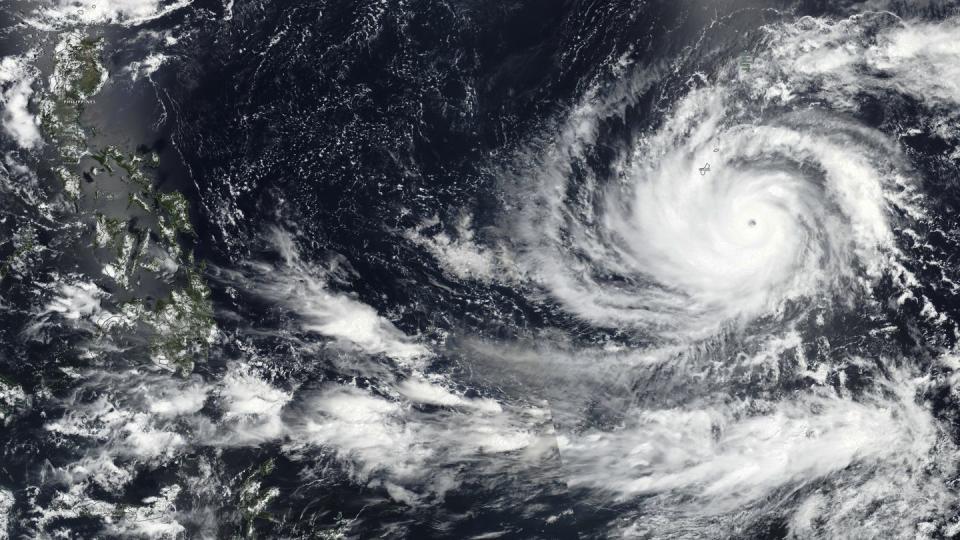
Weathering the storm
Mawar made landfall at Andersen around 9 p.m. local time on May 24, pelting Guam with 140 mph winds and 28 inches of rain.
The base of more than 8,000 people is home to a unit of RQ-4 Global Hawk reconnaissance drones, but largely supports other military operations across the Pacific. It routinely welcomes bomber squadrons on routine deterrence missions, and is a major hub for training exercises around the region.
Aircraft that could be evacuated were sent away before the storm, and those that weren’t were parked in hangars. Families hunkered down to ride out the howling winds and pounding rain in the dark, without cell phone or radio service.
“It’s very traumatizing,” said April Gerstner, a Key Spouse at Andersen whose husband works for the 734th Air Mobility Squadron. “You’re hearing these full-force winds outside. … You keep hearing these loud thuds outside [of palm trees] hitting the ground.”
Key Spouses are volunteers appointed by the unit commander to serve as conduits of information providing resources to Air Force families.
“It’s a lot of unknown and you have to mentally be OK with it,” she said.
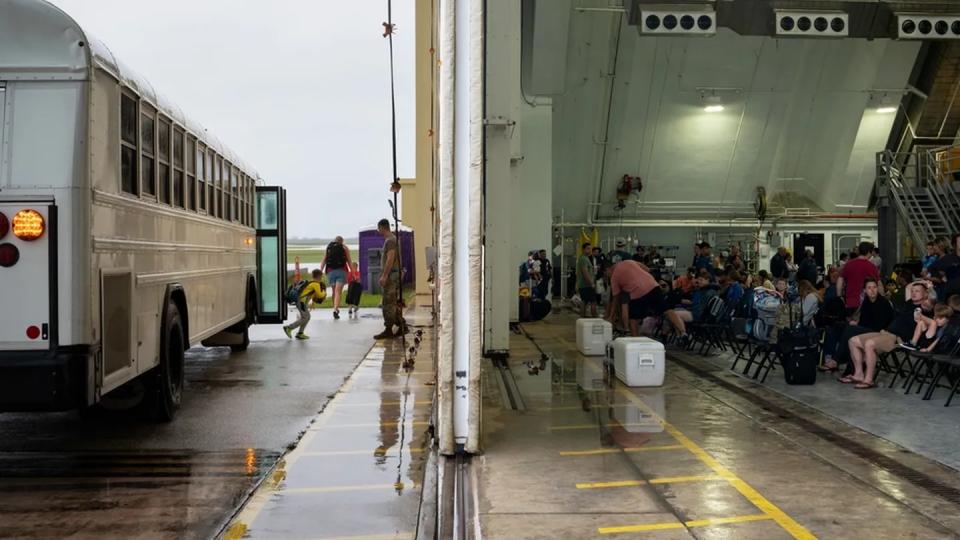
In the weeks that followed, the Air Force Civil Engineer Center dispatched a team to assess the damage, estimate the cost of repairs and craft a way forward. About 500 facilities were damaged, the service said.
“Overall, the structures fared really well. We didn’t lose any buildings. We’re able to continue with our mission,” Col. Dustin Born, Andersen’s on-site cleanup director, told Air Force Times in a recent interview. “But we obviously have a lot of facilities that have, now, water infiltration and water damage.”
For multiple reasons, Andersen fared better against Typhoon Mawar than Tyndall AFB did against Hurricane Michael, a Category 5 storm that devastated the Florida base in 2018, said Col. Robert Bartlow, who oversees the Air Force’s natural disaster recovery efforts as part of AFCEC.
Andersen saw slower winds and no storm surge because it sits at a higher elevation than Tyndall, Bartlow said. And the buildings on Guam were built to withstand Category 5 storms, which whip an area with winds in excess of 157 mph.
Unlike at Tyndall, none of Andersen’s facilities suffered structural damage that would require them to be demolished and rebuilt, Born said.
“There’s a couple of facilities that we’re considering possibly doing some new construction on, just because … it would be cost-prohibitive to repair the building,” he said. “We might be better off just … getting new amenities and building it in a better fashion.”
Gerstner’s outlook was less rosy.
“We’re slowly getting there, but it’s gonna take a really long time, because there are buildings that are just completely destroyed,” she said.
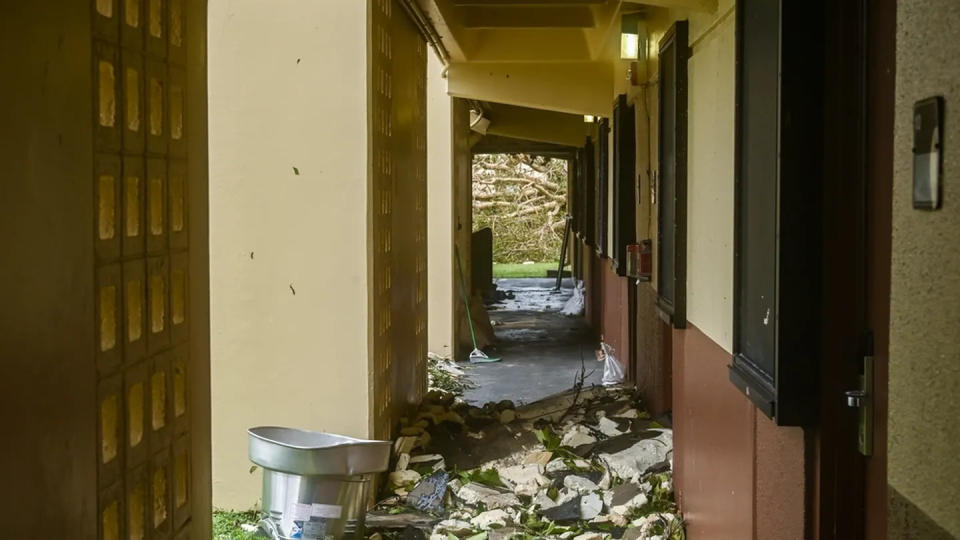
Gerstner added that while sandbags provided by the base helped keep her home from flooding, many at Andersen weren’t as lucky.
“There’s a lot of people that don’t have carpet in their house because their whole house flooded,” she said. “People have mold, especially around their vents.”
Andersen’s on-base airport terminal, where airmen and their families catch rides to the U.S. mainland on contracted jets known as “space-available” flights, was among the worst-hit facilities.
The facility’s water damage and broken roof forced the 734th Air Mobility Squadron, which runs the passenger terminal, to move the jumble of luggage scales and waiting rooms into another squadron’s building.
For several weeks, troops and their families arrived and departed through a massive hangar that typically housed Global Hawk drones, but sat empty while the unit temporarily operated from Japan.
Now, travelers will await their flights at a camp of trailers near the old passenger terminal until its extensive restoration is finished.
“It’ll need to be completely remodeled inside … taking out all the sheetrock, basically, gut it down to the studs, and if those are still good, then it’ll be rebuilt from there,” Born said.
Cleanup is a multi-step process. First, the military works to restore basic utilities like water and power, and moves downed trees that are blocking major roadways and threatening homes. Contractors come in to seal the buildings to ensure that more rain can’t get in during Guam’s frequent tropical showers and any other major storms that follow.
Then buildings get internal makeovers, with new flooring, paint and furniture. Born’s team will look at ways to secure the facilities against stronger storms, like adding roofs that can withstand 200 mph winds and shatter-resistant windows.
The Air Force may add tile to the bottom foot or two of walls to prevent future water damage and mold, Born said.
It’s an “opportunity to make sure that we’re fixing things correctly,” he said. “We’re going to try to find the newest technology that has the best capabilities to withstand another typhoon.”
Large construction projects are made more complicated and expensive by Guam’s distance from the continental U.S. Materials can take up to two months to arrive by ship, Born said.
What’s more, the limited equipment and labor pool must be shared by the island’s public and private sectors, the U.S. Federal Emergency Management Agency and the Pentagon. The 15-hour time difference between Guam and Bartlow’s office in Florida has created other hurdles for program management.
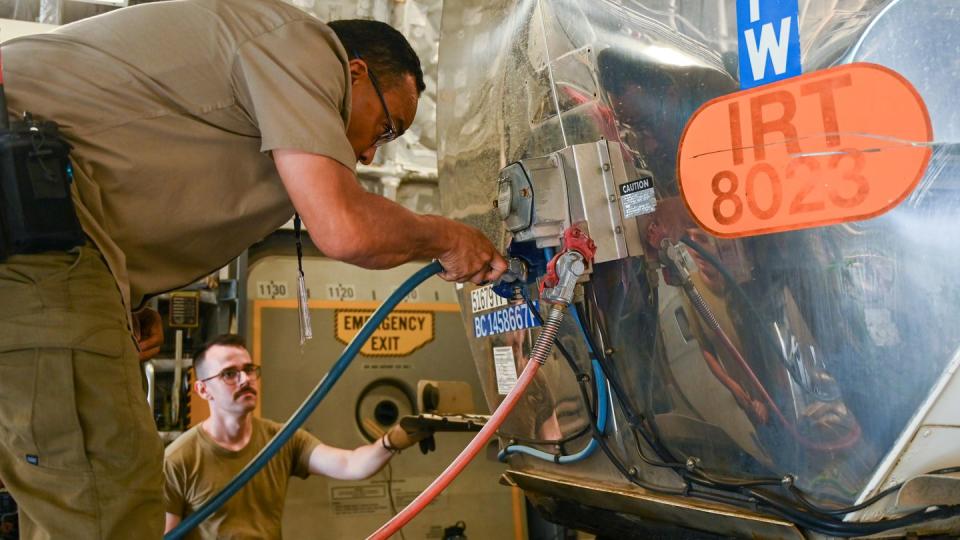
“I think we’ve overcome that,” Bartlow said. “There’s been a great deal of coordination … but it is a challenge.”
Building back better
How much the recovery effort may cost and how long it may take depend on how extensively the Pentagon uses the storm as a chance to build a better base.
Andersen was already in the midst of hundreds of millions of dollars worth of upgrades when Mawar struck. The typhoon has presented more opportunities to improve upon facilities built in the late 1940s.
The Air Force’s fiscal 2024 budget asks Congress to fund a new area on the flight line to fit 14 B-52 Stratofortress bombers and additional tanker aircraft, plus the communications and electrical infrastructure to support those operations.
“Without this apron and the supporting utilities, Andersen AFB will be unable to adequately support the bomber aircraft operations during contingencies, significantly impacting readiness and degrading operational capability,” the service wrote.
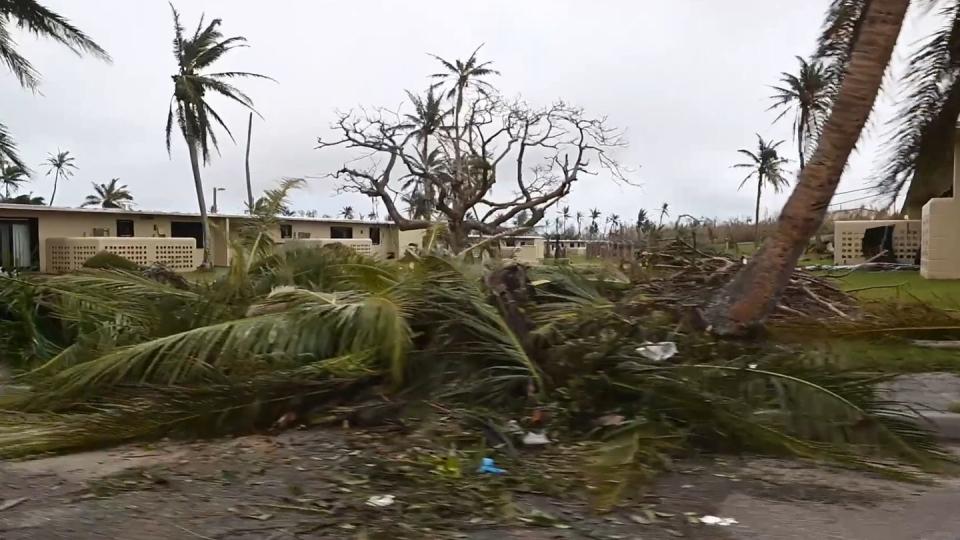
It cautioned that failing to build new parking “may increase the potential for a serious mishap.”
The Air Force in 2021 began work on a new weapons storage complex at Andersen that will house dozens of the long-range missiles seen as crucial in a potential war with China.
“We can rapidly reload bomber aircraft. When they land here, they can get rapidly re-armed and take back off again,” Maj. Timothy Wu, commander of the 36th Munitions Squadron, said last year. “It increases the lethality for a second strike.”
A slew of other air defense projects are poised to turn Guam into the “most densely protected place anywhere on the planet,” defense publication The Drive wrote Aug. 11.
During Minihan’s tour of mobility squadrons at the base, airmen pointed out that certain hangars were built to Navy standards rather than the Air Force’s, making them too small to comfortably move equipment.
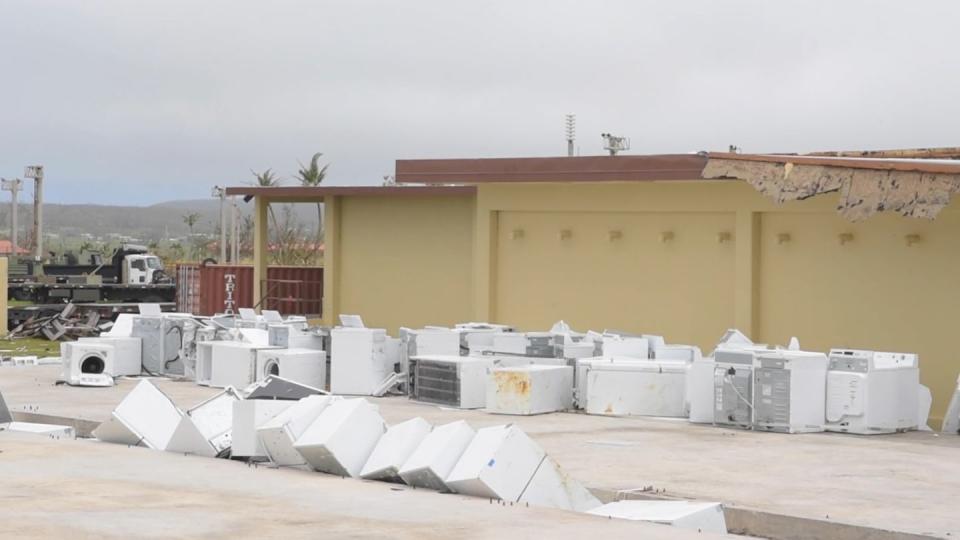
That issue and more could be wrapped into the Air Force’s post-storm plan for Andersen.
To pay for it, a first tranche of money could come as part of a stopgap bill to fund the federal government in the early months of fiscal 2024, while Congress hashes out an appropriations package to last the rest of the year.
“We were able to take money from our FY ‘23 … appropriations to start some of the immediate emergency repairs,” Born said. “As we dwindle down to the end of FY ‘23 … we are looking for special appropriations to make ‘24 flow through smoothly so we can continue our repairs.”
Further funding would factor into the Pentagon’s annual budget request in fiscal 2025 and beyond.
“It’s complicated by the fact that we’ve got multiple services and installations, and a U.S. territory involved here,” Bartlow said. “I think there’s differing approaches on how … you fund this, recognizing the fact that it’s got to be coordinated.”
Guam’s status as a U.S. territory gives it a smaller congressional delegation than states — one nonvoting member in the House of Representatives — which can hamper its ability to advocate for more funds and attention.
But Guam’s strategic importance in the Pacific has made it a prime destination for federal investment and garnered more interest from U.S. politicians. It has welcomed a growing number of federal lawmakers and military leaders on official visits, and recently hosted its first congressional field hearing since 2007.
“I think they’re able to see pretty clearly the level of impact, and the need for making sure that our strategic interests are repaired and aligned with what the nation needs,” Born said.

‘Just a normal day’
While the Pentagon mounts its recovery effort, airmen are contending with the realities of daily life after a natural disaster.
Finding fresh, good-quality food has been difficult, Gerstner said, as have periodic power outages as the island repairs its electrical grid.
Typhoon Mawar exacerbated the longstanding difficulties that military spouses have with finding jobs on Guam, and stretched mental health services even thinner. And the order barring new airmen from arriving at Andersen also strained squadrons that are perennially short-staffed, Gerstner said.
Some airmen have taken to social media to complain about food prices, moldy dormitories and other housing problems.
An anonymous complaint posted Aug. 15 on the unofficial “Air Force amn/nco/snco” Facebook page appears to show nearly bare shelves at a military-run grocery store.
“Just a normal day at the commissary here in Guam,” the post read. “Off to the grocery store out in town where I’ll pay $15+ dollars for a gallon of milk alone.”
Ahead of the storm, the Pentagon shrank its cost-of-living allowance for troops stationed overseas, arguing that the price of goods and services was on par with those in the continental U.S.
That left Andersen airmen with less in their wallets amid post-typhoon spikes in food and gas prices. Gerstner said it has forced her family to think twice about their purchases and buy lower-quality food than they might otherwise eat.
On Aug. 1, Joint Region Marianas announced the Pentagon had canceled another planned cut to the allowance of those stationed in Guam. The second decrease was scheduled for November.
Gerstner praised the responsiveness of base leaders and the Andersen community throughout the crisis, and wants to see more typhoon-preparation classes for airmen and their families to keep people safer in the future.
But healing emotional wounds from the storm will take time.
“Some days I have good days, where it’s like, ‘Oh, we’re getting back to normal. Things are looking great,’” Gerstner said. “Then I see something — it could be a post, or it could be a part of the island that still looks really bad — and it feels like it’s the week after the typhoon again.”


